甲藻门环胺螺环藻属和环胺螺环藻酸研究进展
- 格式:doc
- 大小:27.50 KB
- 文档页数:5
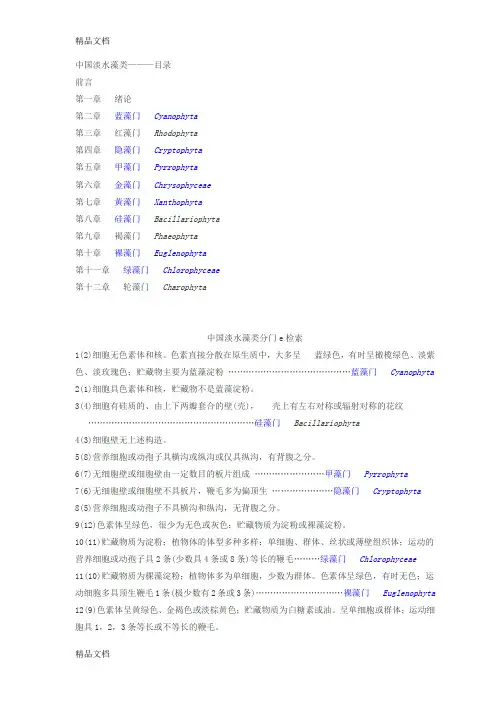
中国淡水藻类———目录前言第一章绪论第二章蓝藻门Cyanophyta第三章红藻门Rhodophyta第四章隐藻门Cryptophyta第五章甲藻门Pyrrophyta第六章金藻门Chrysophyceae第七章黄藻门Xanthophyta第八章硅藻门Bacillariophyta第九章褐藻门Phaeophyta第十章裸藻门Euglenophyta第十一章绿藻门Chlorophyceae第十二章轮藻门Charophyta中国淡水藻类分门e检索1(2)细胞无色素体和核。
色素直接分散在原生质中,大多呈蓝绿色,有时呈橄榄绿色、淡紫色、淡玫瑰色;贮藏物主要为蓝藻淀粉……………………………………蓝藻门Cyanophyta 2(1)细胞具色素体和核,贮藏物不是蓝藻淀粉。
3(4)细胞有硅质的、由上下两瓣套合的壁(壳),壳上有左右对称或辐射对称的花纹…………………………………………………硅藻门Bacillariophyta4(3)细胞壁无上述构造。
5(8)营养细胞或动孢子具横沟或纵沟或仅具纵沟,有背腹之分。
6(7)无细胞壁或细胞壁由一定数目的板片组成……………………甲藻门Pyrrophyta7(6)无细胞壁或细胞壁不具板片,鞭毛多为偏顶生…………………隐藻门Cryptophyta8(5)营养细胞或动孢子不具横沟和纵沟,无背腹之分。
9(12)色素体呈绿色,很少为无色或灰色;贮藏物质为淀粉或裸藻淀粉。
10(11)贮藏物质为淀粉;植物体的体型多种多样:单细胞、群体、丝状或薄壁组织体;运动的营养细胞或动孢子具2条(少数具4条或8条)等长的鞭毛………绿藻门Chlorophyceae11(10)贮藏物质为棵藻淀粉;植物体多为单细胞,少数为群体。
色素体呈绿色,有时无色;运动细胞多具顶生鞭毛1条(极少数有2条或3条)…………………………裸藻门Euglenophyta 12(9)色素体呈黄绿色、金褐色或淡棕黄色;贮藏物质为白糖素或油。
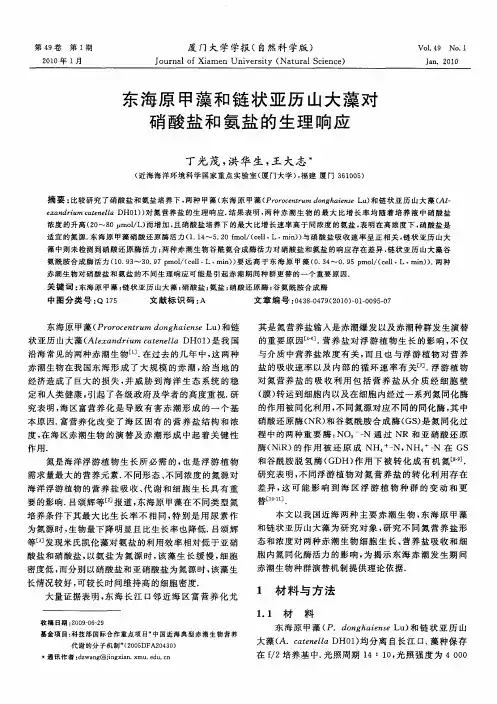
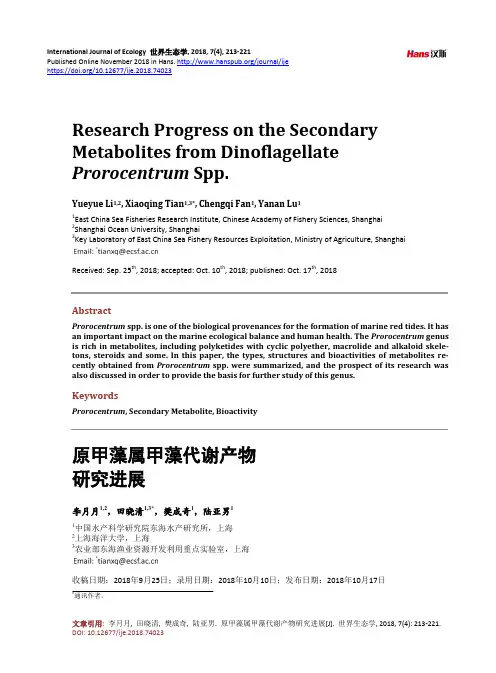
International Journal of Ecology 世界生态学, 2018, 7(4), 213-221Published Online November 2018 in Hans. /journal/ijehttps:///10.12677/ije.2018.74023Research Progress on the SecondaryMetabolites from DinoflagellateProrocentrum Spp.Yueyue Li1,2, Xiaoqing Tian1,3*, Chengqi Fan1, Yanan Lu11East China Sea Fisheries Research Institute, Chinese Academy of Fishery Sciences, Shanghai2Shanghai Ocean University, Shanghai3Key Laboratory of East China Sea Fishery Resources Exploitation, Ministry of Agriculture, ShanghaiReceived: Sep. 25th, 2018; accepted: Oct. 10th, 2018; published: Oct. 17th, 2018AbstractProrocentrum spp. is one of the biological provenances for the formation of marine red tides. It has an important impact on the marine ecological balance and human health. The Prorocentrum genus is rich in metabolites, including polyketides with cyclic polyether, macrolide and alkaloid skele-tons, steroids and some. In this paper, the types, structures and bioactivities of metabolites re-cently obtained from Prorocentrum spp. were summarized, and the prospect of its research was also discussed in order to provide the basis for further study of this genus.KeywordsProrocentrum, Secondary Metabolite, Bioactivity原甲藻属甲藻代谢产物研究进展李月月1,2,田晓清1,3*,樊成奇1,陆亚男11中国水产科学研究院东海水产研究所,上海2上海海洋大学,上海3农业部东海渔业资源开发利用重点实验室,上海收稿日期:2018年9月25日;录用日期:2018年10月10日;发布日期:2018年10月17日*通讯作者。

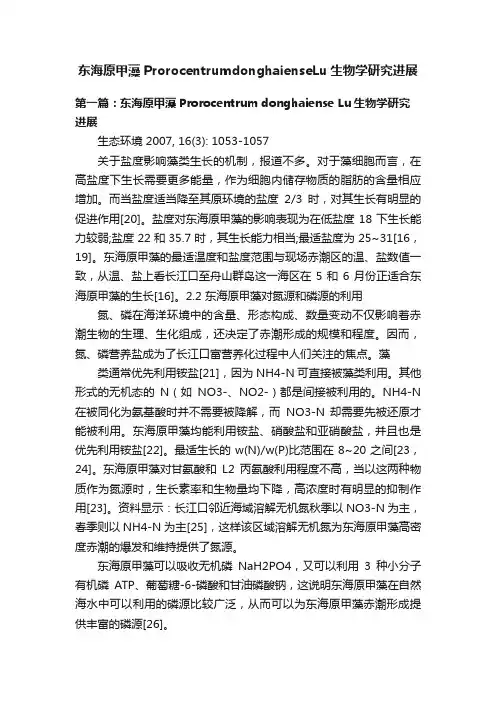
东海原甲藻ProrocentrumdonghaienseLu生物学研究进展第一篇:东海原甲藻Prorocentrum donghaiense Lu生物学研究进展生态环境 2007, 16(3): 1053-1057关于盐度影响藻类生长的机制,报道不多。
对于藻细胞而言,在高盐度下生长需要更多能量,作为细胞内储存物质的脂肪的含量相应增加。
而当盐度适当降至其原环境的盐度2/3时,对其生长有明显的促进作用[20]。
盐度对东海原甲藻的影响表现为在低盐度18下生长能力较弱;盐度22和35.7时,其生长能力相当;最适盐度为25~31[16,19]。
东海原甲藻的最适温度和盐度范围与现场赤潮区的温、盐数值一致,从温、盐上看长江口至舟山群岛这一海区在5和6月份正适合东海原甲藻的生长[16]。
2.2 东海原甲藻对氮源和磷源的利用氮、磷在海洋环境中的含量、形态构成、数量变动不仅影响着赤潮生物的生理、生化组成,还决定了赤潮形成的规模和程度。
因而,氮、磷营养盐成为了长江口富营养化过程中人们关注的焦点。
藻类通常优先利用铵盐[21],因为NH4-N可直接被藻类利用。
其他形式的无机态的N(如NO3-、NO2-)都是间接被利用的。
NH4-N 在被同化为氨基酸时并不需要被降解,而NO3-N 却需要先被还原才能被利用。
东海原甲藻均能利用铵盐、硝酸盐和亚硝酸盐,并且也是优先利用铵盐[22]。
最适生长的w(N)/w(P)比范围在8~20之间[23,24]。
东海原甲藻对甘氨酸和L2丙氨酸利用程度不高,当以这两种物质作为氮源时,生长素率和生物量均下降,高浓度时有明显的抑制作用[23]。
资料显示:长江口邻近海域溶解无机氮秋季以NO3-N为主,春季则以NH4-N 为主[25],这样该区域溶解无机氮为东海原甲藻高密度赤潮的爆发和维持提供了氮源。
东海原甲藻可以吸收无机磷NaH2PO4,又可以利用3种小分子有机磷ATP、葡萄糖-6-磷酸和甘油磷酸钠,这说明东海原甲藻在自然海水中可以利用的磷源比较广泛,从而可以为东海原甲藻赤潮形成提供丰富的磷源[26]。
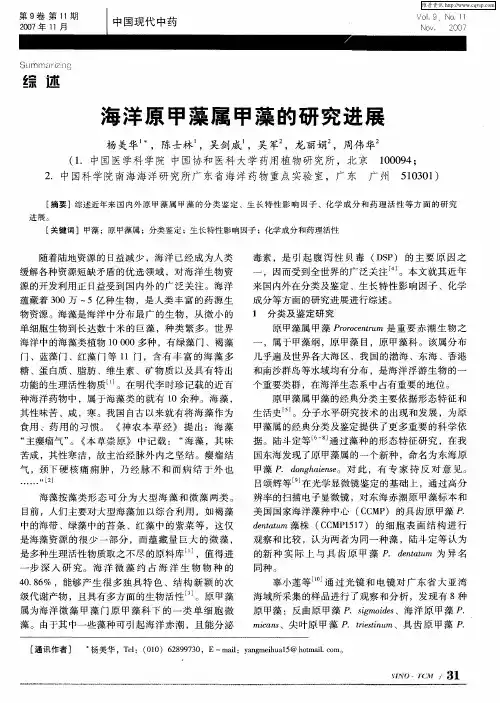
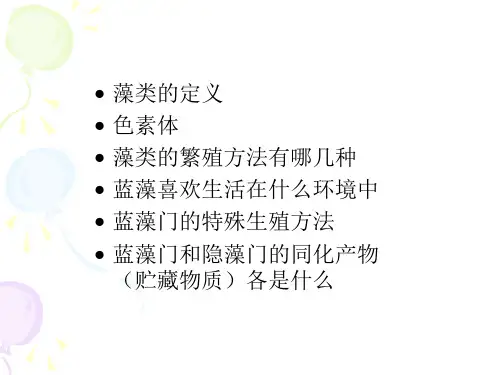
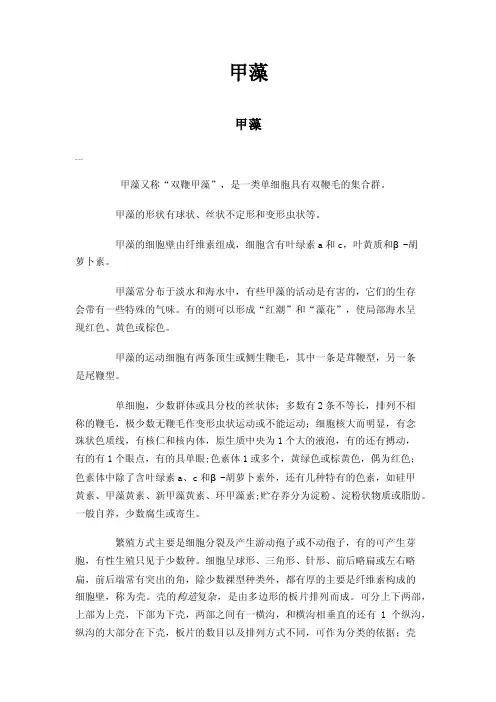
甲藻甲藻00甲藻又称“双鞭甲藻”,是一类单细胞具有双鞭毛的集合群。
甲藻的形状有球状、丝状不定形和变形虫状等。
甲藻的细胞壁由纤维素组成,细胞含有叶绿素a和c,叶黄质和β-胡萝卜素。
甲藻常分布于淡水和海水中,有些甲藻的活动是有害的,它们的生存会带有一些特殊的气味。
有的则可以形成“红潮”和“藻花”,使局部海水呈现红色、黄色或棕色。
甲藻的运动细胞有两条顶生或侧生鞭毛,其中一条是茸鞭型,另一条是尾鞭型。
单细胞,少数群体或具分枝的丝状体;多数有2条不等长,排列不相称的鞭毛,极少数无鞭毛作变形虫状运动或不能运动;细胞核大而明显,有念珠状色质线,有核仁和核内体,原生质中央为1个大的液泡,有的还有搏动,有的有1个眼点,有的具单眼;色素体1或多个,黄绿色或棕黄色,偶为红色;色素体中除了含叶绿素a、c和β-胡萝卜素外,还有几种特有的色素,如硅甲黄素、甲藻黄素、新甲藻黄素、环甲藻素;贮存养分为淀粉、淀粉状物质或脂肪。
一般自养,少数腐生或寄生。
繁殖方式主要是细胞分裂及产生游动孢子或不动孢子,有的可产生芽胞,有性生殖只见于少数种。
细胞呈球形、三角形、针形、前后略扁或左右略扁,前后端常有突出的角,除少数裸型种类外,都有厚的主要是纤维素构成的细胞壁,称为壳。
壳的构造复杂,是由多边形的板片排列而成。
可分上下两部,上部为上壳,下部为下壳,两部之间有一横沟,和横沟相垂直的还有1个纵沟,纵沟的大部分在下壳,板片的数目以及排列方式不同,可作为分类的依据;壳面光滑或有穿孔的真孔,或周围厚而中央薄的拟孔;壳面有的平直,有的具小刺或突起。
细胞核1个,圆形、椭圆形、细长棒状或弯曲呈香肠状。
核仁1至数个。
染色体排列如串珠状,某些种的染色体为层片状(如南京产的双脚多甲藻)。
细胞质一般外层较浓、呈颗粒状,含有色素体;内层有细胞核和液泡,鞭毛孔附近的细胞质多呈液状,可以伸出原生质线来。
色素体呈圆盘状,多数排列于细胞质的外层,但也有梭形或带状的呈放射状排列。


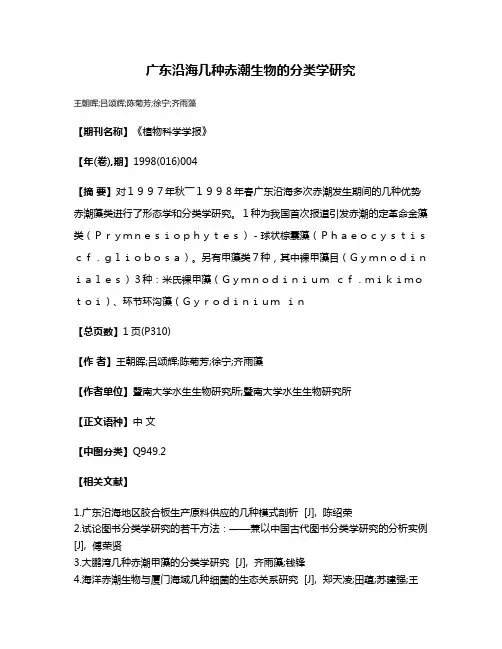
广东沿海几种赤潮生物的分类学研究
王朝晖;吕颂辉;陈菊芳;徐宁;齐雨藻
【期刊名称】《植物科学学报》
【年(卷),期】1998(016)004
【摘要】对1997年秋 ̄1998年春广东沿海多次赤潮发生期间的几种优势赤潮藻类进行了形态学和分类学研究。
1种为我国首次报道引发赤潮的定革命金藻类(Prymnesiophytes)-球状棕囊藻(Phaeocystiscf.gliobosa)。
另有甲藻类7种,其中裸甲藻目(Gymnodiniales)3种:米氏裸甲藻(Gymnodiniumcf.mikimotoi)、环节环沟藻(Gyrodiniumin
【总页数】1页(P310)
【作者】王朝晖;吕颂辉;陈菊芳;徐宁;齐雨藻
【作者单位】暨南大学水生生物研究所;暨南大学水生生物研究所
【正文语种】中文
【中图分类】Q949.2
【相关文献】
1.广东沿海地区胶合板生产原料供应的几种模式剖析 [J], 陈绍荣
2.试论图书分类学研究的若干方法:——兼以中国古代图书分类学研究的分析实例[J], 傅荣贤
3.大鹏湾几种赤潮甲藻的分类学研究 [J], 齐雨藻;钱锋
4.海洋赤潮生物与厦门海域几种细菌的生态关系研究 [J], 郑天凌;田蕴;苏建强;王
艳丽;连玉武;洪华生
5.几种梓属植物花粉形态及分类学意义 [J], 贾继文;麻文俊;王军辉;张金凤;张守攻;张建国;赵鲲
因版权原因,仅展示原文概要,查看原文内容请购买。
第4章甲藻门Pyrrophyta甲藻是海洋浮游生物的一个重要类群,在海洋生态系中占极为重要的地位。
大多数甲藻个体微小,为单细胞体制,有的单细胞通过细胞外的各种突起,联结成不同形状的群体。
甲藻能通过光合作用,合成大量有机物,其产量可作为海洋生产力的指标,与海产经济动物有密切的关系,有人将其称为“海洋牧草”。
甲藻中的许多种类在特定的环境下能大量繁殖,从而形成“赤潮”,对海洋生态及渔业危害很大。
由于引起赤潮的生物种类不同,其危害程度和方式也不同,夜光藻等赤潮种类,可使海水缺氧,堵塞动物的呼吸器官,而导致生物窒息。
有些甲藻还可分泌毒素,有些毒素可直接毒害其它水生生物,如短裸甲藻Gymnodinium breve所分泌的神经性毒素,释放进入到海水以后,能使鱼、虾、贝类等大量死亡。
多边膝沟藻Gonyaulax polyedra则在藻体死亡后产生毒素,危害海洋生物。
而有些种类产生的毒素对鱼类、贝类等虽不造成直接致命影响,但可在它们体内积累,如果人类或其它脊椎动物食用了这些有毒鱼类、贝类就会发生中毒、死亡,如织纹螺、波纹唇鱼、河鲀鱼等。
不少甲藻也具有发光能力,如夜光藻,细胞个体大,是研究发光生理的良好材料。
甲藻也是间核生物,是原核生物向真核生物进化的中介型,它们的形成、分类研究,将为生物进化理论提供新的参考资料。
全世界约有甲藻2000余种,海水、淡水、半咸水均有分布,多数种类分布于海洋,几乎世界各大海区都有它的踪迹,少数产于淡水或半咸淡水。
4.1、甲藻的主要形态特征1)、外形特征及体制大多数甲藻为单细胞,且具2条鞭毛,可以运动。
外形多种,细胞常呈球形或针形、梭形、卵圆形等,背腹扁平或左右侧扁,常有背腹之分。
细胞裸露或具纤维质细胞壁(壳)。
纵裂甲藻类,细胞由左右二片组成,无纵沟(longitudinal furrow) 和横沟(tranverse furrow)。
横裂甲藻类的细胞壁则由许多小板组成,板片有时有角、刺或乳头状突起,板片表面常具孔纹。
中国近海藻毒素及有毒微藻产毒原因种调查研究进展梁玉波;李冬梅;姚敬元;金薇;宫长宝;刘仁沿【摘要】麻痹性贝类毒素在我国近海污染问题已十分突出,基本呈现逐年加剧的趋势.20世纪90年代,南海麻痹性贝类毒素污染较重;21世纪初,北黄海麻痹性贝类毒素污染较重;近几年,渤海和福建近海麻痹性贝类毒素污染较重;可产生麻痹性贝类毒素的微藻有亚历山大藻和裸甲藻等.采用小鼠生物法检测我国近海腹泻性贝类毒素超标率32%左右,采用液相色谱/质谱法检测,仅有3起超标的研究报道;现行小鼠生物法检测腹泻性贝类毒素假阳性问题十分突出,应尽快废除;腹泻性贝类毒素均是脂溶性的,脂溶性海洋生物毒素在我国近海常年可检出,偶有虾夷扇贝毒素和鳍藻毒素超标现象.可产生脂溶性毒素微藻有鳍藻和原甲藻及网状原角藻等.失忆性贝类毒素在我国近海常有检出,但无超标现象;产毒微藻有拟菱形藻等.西加鱼毒素在我国南海污染较重,但毒素标准物质的匮乏,限制了西加鱼毒素的调查研究;至今尚未确定产生西加鱼毒素的微藻.酶联免疫吸附法和液相色谱串联质谱法相结合已成为藻毒素快速准确检测成熟的技术,逐渐代替小鼠生物法和液相色谱法.【期刊名称】《海洋与湖沼》【年(卷),期】2019(050)003【总页数】14页(P511-524)【关键词】中国近海;藻毒素;有毒微藻;毒素检测方法【作者】梁玉波;李冬梅;姚敬元;金薇;宫长宝;刘仁沿【作者单位】国家海洋环境监测中心大连 116023;大连市藻毒素重点实验室大连116023;国家海洋环境监测中心大连 116023;大连市藻毒素重点实验室大连116023;国家海洋环境监测中心大连 116023;大连市藻毒素重点实验室大连116023;国家海洋环境监测中心大连 116023;大连市藻毒素重点实验室大连116023;国家海洋环境监测中心大连 116023;大连市藻毒素重点实验室大连116023;国家海洋环境监测中心大连 116023;大连市藻毒素重点实验室大连116023【正文语种】中文【中图分类】P714+.5海洋藻毒素主要是由海洋有毒微藻产生的活性物质,贝类等摄食了有毒微藻,就会将毒素富集于体内,人类食用了藻毒素污染的贝类等海产品就会中毒甚至死亡。
6种赤潮甲藻对荧光标记藻类的吞噬行为研究张淑雯;张云;欧林坚;齐雨藻;吕颂辉【期刊名称】《海洋与湖沼》【年(卷),期】2012(043)003【摘要】选取6种在中国沿海广泛分布的赤潮甲藻米氏凯伦藻(Kareniamikimotoi)、链状亚历山大藻似lexandriumcatenella)、东海原甲藻(Prorocentrumdonghaiense)、海洋原甲藻(Prorocentrummicans)、微小原甲藻(Prorocentrumminimum)和锥状斯氏藻(Scrippsiellatrochoidea),采用经5-(4,6-二氯三嗪基)氨基荧光素(DTAF)标记灭活的荧光饵料藻进行投喂,观察目标甲藻是否存在吞噬行为,研究光照、营养盐条件对目标甲藻的吞噬行为的影响。
结果发现,链状亚历山大藻能吞噬旋转海链藻(Thalassiosiracurviseriata),东海原甲藻能摄食球等鞭金藻(1sochrysisgalbana),但其摄食概率非常低.且不受光照和营养盐条件的影响。
实验中,未观测到米氏凯伦藻、海洋原甲藻、微小原甲藻和锥状斯氏藻的吞噬行为。
在黑暗中培养48—72h后,目标甲藻均出现不同程度的死亡,尤其是东海原甲藻和链状亚历山大藻。
虽然东海原甲藻和链状亚历山大藻具吞噬行为属于混合营养生物,但光合自养是目标甲藻获取营养、维持生长最主要的方式。
%Six dinoflagellates species Karenia mikimotoi, Alexandrium catenella, Prorocentrum donghaiense, Proro- centrum micans, Prorocentrum minimum and Scrippsiella trochoidea were chosen as the target species. The preys which were labeled with 5-(4,6-Dichlorotriazinyl)aminofluorescein (DTAF) as the fluorescent labeled algae (FLA) wereadded to investigate whether the six dinoflagellates had the capability of phagotrophy and to analyze the influence of light and nutrients on their phagotrophic behavior. Results showed that A. catenella could ingest the fluorescent labeled Thalassiosira curviseriata and P donghaiense could ingest the fluorescent labeled lsochrysis galbana. These two species had the capa- bility of phagotrophy and thus belonged to the mixotrophic organisms. However, for both species, the grazing frequencies were so low and the phagotrophic behavior was not influenced by the variation of light and nutrient concentrations. No phagotrophic behavior was detected for the species of K. mikimotoi, P. micans, P minimum and S. trochoidea. After inocu- lation in the dark for 48--72h, the dinoflagellates died in different extent, especially P minimum and A. catenella. All these results support that phototrophy was the major mode in gaining nutrition and sustaining the growth for the target dinoflag- ellates.【总页数】7页(P602-608)【作者】张淑雯;张云;欧林坚;齐雨藻;吕颂辉【作者单位】暨南大学赤潮与海洋生物学研究中心,广州510632;暨南大学赤潮与海洋生物学研究中心,广州510632;暨南大学赤潮与海洋生物学研究中心,广州510632;暨南大学赤潮与海洋生物学研究中心,广州510632;暨南大学赤潮与海洋生物学研究中心,广州510632【正文语种】中文【中图分类】P735【相关文献】1.用荧光原位杂交(FISH)技术鉴定赤潮甲藻的研究 [J], 张宝玉;王广策;齐雨藻;邹景忠;曾呈奎2.光照及营养盐对3种赤潮甲藻吞噬营养行为的影响 [J], 张淑雯;欧林坚;吕颂辉;陈菊芳3.用荧光标记细菌法研究丝兰提取物对瘤胃原虫对细菌吞噬的影响 [J], 曹恒春;王洪荣;王梦芝;李国祥;徐爱秋4.荧光染色标记细菌法对瘤胃原虫吞噬细菌速率的研究 [J], 曹恒春;王梦芝;王洪荣5.用荧光标记法研究瘤胃原虫吞噬细菌的初探 [J], 曹恒春;王洪荣;王梦芝;徐爱秋;李国祥因版权原因,仅展示原文概要,查看原文内容请购买。
2011年胶州湾网采浮游植物群落结构及其环境影响因子罗璇;孙晓霞;郑珊;赵永芳【摘要】本文于2011年1-12月对胶州湾海域浮游植物进行了周年调查,获得了同步的温盐和营养盐数据,分析了浮游植物丰度、优势种类、多样性指数和季节变化特征及其与环境影响因子的关系.结果表明:共检出浮游植物108种(包括变种和变型),其中硅藻门34属93种,甲藻门6属14种,金藻门1属1种.浮游植物主要由硅藻和甲藻两大类组成,其中硅藻占绝对优势,全年甲藻/硅藻比均小于0.08.优势种共有35种,夏、冬季优势种交替明显,全年几乎均出现的种类为圆筛藻(Coscinodiscus spp.),旋链角毛藻(Chaetoceros curvisetus)和中肋骨条藻(Skeletonema costatum).生态类型主要以广布种、广温近岸种、温带近岸种为主,也出现了少数暖水种和外洋种.浮游植物丰度分别在2月、4月和7月份达到峰值,其中4月全年最高,为591×106cell/m3,2月是次高峰,数量为468×106cell/m3,7月为172× 106cell/m3,秋季浮游植物丰度相对较低.本研究结果与胶州湾浮游植物典型双峰型变化不同.浮游植物群落多样性指数平均为2.4,秋、冬季节较高,春、夏季节偏低,水平分布上呈现湾外>湾口>湾内的趋势,均匀度平均值为0.26,分布趋势与多样性指数基本相同.由此可见,湾外浮游植物群落结构较湾口和湾内更为稳定,温度、硅酸盐、亚硝酸盐、硝酸盐、铵盐和磷酸盐对浮游植物丰度和群落结构存在明显影响.【期刊名称】《海洋与湖沼》【年(卷),期】2016(047)005【总页数】9页(P915-923)【关键词】胶州湾;浮游植物;群落结构;周年变化;环境因子【作者】罗璇;孙晓霞;郑珊;赵永芳【作者单位】山东胶州湾海洋生态系统国家野外科学观测研究站青岛 266071;山东胶州湾海洋生态系统国家野外科学观测研究站青岛 266071;青岛海洋科学与技术国家实验室海洋生态与环境科学功能实验室青岛 266071;中国科学院大学北京100049;山东胶州湾海洋生态系统国家野外科学观测研究站青岛 266071;山东胶州湾海洋生态系统国家野外科学观测研究站青岛 266071【正文语种】中文【中图分类】Q178.1位于食物链金字塔底端的浮游植物是海洋生态系统中最重要的初级生产者。
2013年夏季北黄海浮游植物群集张健;李佳芮;翟伟康;潘嵩;王园君【期刊名称】《海洋学研究》【年(卷),期】2015(33)3【摘要】利用Uterm(o)hl方法,对2013年夏季取得的北黄海浮游植物样品进行鉴定分析,共鉴定出浮游植物3门60属114种(不包括未定名种),其中,硅藻42属75种,甲藻16属37种,金藻2属2种.群落组成以硅藻为主,其次是甲藻,然后是金藻.调查海区浮游植物的生态类型以温带近岸性为主,主要优势种为:小等刺硅鞭藻Dictyocha fibula、裸甲藻Gymnodinium sp.、螺旋环沟藻Gyrodinium spirale、蜂腰双壁藻Diploneis bombus和具槽帕拉藻Paralia sulcata.浮游植物细胞丰度介于0.037 0×103~32.3×103cells· L-1,平均值为2.04×103cells·L-1;浮游植物细胞丰度大致从近岸到外海呈逐步降低趋势,在北黄海西部近岸的表层水体达到最高值32.3×103cells·L-1,调查区东南部靠近外海区域也出现了丰度高值区;浮游植物垂直分布总体特征是随水深的增加而减少,由近岸向外海逐步降低.香农-威纳多样性指数在调查区西南部较高,而Pielou均匀度指数则在东部呈现高值区域.典范对应分析(CCA)显示,影响浮游植物优势种丰度分布的主要因素是营养盐,而跟盐度和温度的相关性不明显.【总页数】7页(P84-90)【作者】张健;李佳芮;翟伟康;潘嵩;王园君【作者单位】国家海洋信息中心,天津300171;国家海洋信息中心,天津300171;国家海洋信息中心,天津300171;国家海洋信息中心,天津300171;国家海洋信息中心,天津300171【正文语种】中文【中图分类】Q178.53【相关文献】1.2013年夏季南黄海浮游植物群集 [J], 张健;李佳芮2.北黄海典型水域春夏季浮游植物的昼夜变化 [J], 杨世民;刘光兴3.夏季东海PN断面浮游植物群集 [J], 郭术津;孙军;汪岷4.2005年夏季长江口水域浮游植物群集特征及其与环境因子的关系 [J], 栾青杉;孙军5.2009年夏季东海浮游植物群集 [J], 郭术津;田伟;戴民汉;刘志亮;孙军因版权原因,仅展示原文概要,查看原文内容请购买。
甲藻门环胺螺环藻属和环胺螺环藻酸研究进展作者:刘丽丽来源:《安徽农业科学》2014年第11期摘要环胺螺环藻酸(Azaspiracid, AZA)是最近发现的一种贝类毒素,近年来在毒素成分、结构和毒性大小以及产生这类毒素的甲藻物种多样性研究上取得了快速的进展。
对产毒藻的物种多样性、地理分布、形态学和系统发育以及毒素成分的研究进展进行了综述。
关键词甲藻;环胺螺环藻酸;环胺螺环藻属;贝类毒素中图分类号 S917 文献标识码 A 文章编号 0517-6611(2014)11-03293-03Abstract Azaspiracid is a recently reported shellfish toxin. In recent years, great progresses have been made on toxin composition, structures, toxicity, and dinoflagellate diversity responsible for these toxins. Here we review the species diversity and biogeography of these toxic dinoflagellates, morphology and phylogeny, and toxin composition.Key words Dinoflagellate; Azaspiracid; Azadinium; Shellfish toxin环胺螺环藻酸(Azaspiracid, AZA)是一类聚醚类生物毒素,其结构包括1个环胺(Cyclic amine/aza group)、3个螺环(Trispiroassembly)和1个羧酸(Carboxylic acid),因此得名 AZA-SPIR-ACID。
人食用AZA毒素污染的贝类会出现恶心、呕吐、腹泻、胃痉挛等症状,因此欧盟通过立法确立了双壳软体动物中AZA的最大检出限(160 μg/kg贝肉)。
在所有已知的海洋贝类毒素中,AZA毒素是最晚发现的一类,但最近几年在产毒藻的分类学研究、毒素衍生物的结构分析等领域取得了飞速的发展。
笔者对产毒藻的物种多样性、地理分布、形态学和系统发育以及毒素成分的研究进展进行了综述,并对今后的研究方向进行了展望。
1 环胺螺环藻贝类毒素产毒藻1.1 物种多样性和地理分布1995年在荷兰发生了食用贻贝造成的中毒事件[1],3年后这种毒素被命名为环胺螺环藻酸-1(AZA1)[2]。
2009年,AZA毒素被确定是由环胺藻属(Azadinium)的甲藻产生的。
迄今为止该属已经描述了7个物种,首先在苏格兰所属的北海发现了具刺环胺藻(Azadinium spinosum)[3],此后从同一个海域发现了肥胖环胺藻(Azadinium obesum)[4],接着在丹麦所属的北海发现了腹孔环胺藻(Azadinium poporum)[5]。
2012年,在法国发现的Amphidoma caudata被转移到环胺藻属,并建立了2个变种,尾环胺藻尾变种和尾环胺藻玛格丽变种(var. caudatum 和Azadinium caudata var. Margalefii)[6];同年在苏格兰设德兰群岛又发现了长孔环胺藻(Azadinium polongum)[7]。
2013年于地中海发现了右侧环胺藻(Azadinium dexteroporum)[8]。
唯一在欧洲以外发现的物种是大连环胺藻(Azadinium dalianense)[9],分离自我国大连海域。
环胺藻除了自由生活外,还可以与放射虫共生[10]。
环胺藻属的生物地理分布信息还十分有限,腹孔环胺藻在韩国和我国海域都有分布[11-12],具刺环胺藻在阿根廷海域引发过赤潮[13],也分布在墨西哥海域[14]。
1.2 形态学除了尾环胺藻外,其他的环胺藻无论是大小还是形态都很接近(表1)。
已描述的物种都是自养型的,靠近细胞表层有1个叶绿体。
大部分种类在光镜下可以看到像环一样的柄状淀粉粒。
环胺藻属的甲板方程式是Po,cp,X,4′,3a,6′′,C6,5S,6′′′,2′′′′,唯一的例外是大连环胺藻,其顶板只有3块,前间插板只有2块,因此对环胺藻属的定义也相应进行了修订[9]。
环胺藻属的细胞都有1个明显的顶孔复合体,包括1块顶孔板和1块导沟板。
顶孔板中央有1个顶孔,被1块盖板盖住。
导沟板有特殊的三维结构。
5块纵沟板的排列也非常有特点。
前纵沟板很大,侵入细胞上壳,左纵沟板狭长,从第2块横沟板一直延伸到第6块横沟板。
部分物种的第2块底板有1根很小的刺(具刺环胺藻,长孔环胺藻和右侧环胺藻)或者1个明显的角(尾环胺藻)。
环胺藻都有1个明显的腹孔,但各个物种腹孔的位置并不相同,是种间区分的重要特征之一(表1)。
1.3 系统发育 3 展望目前环胺藻属已经发现了7个物种,但是其物种多样性的研究还远未结束,而其生物地理分布的研究则刚刚起步。
基于分子序列的定量PCR法和原位杂交荧光检测技术可用于检测水体中的环胺藻[32],该技术不仅可以用于生物地理学的研究,而且可以用于研究产毒环胺藻的季节变化,从而为贝类毒素含量的监测提供依据。
目前大部分环胺螺环藻酸成分的毒性还不清楚,因此研究各种成分,尤其是AZA-40、AZA-41等成分的毒性是今后急需开展的工作,对这些新发现的毒素成分结构进行研究则有助于理解毒性大小的变化。
转录组学技术的发展为寻找相关的环胺螺环藻酸基因提供了可能,由于同一物种存在有毒株和无毒株,因此发展针对产毒基因的检测技术更具有针对性。
参考文献[1]MCMAHON T,SILKE J.Winter toxicity of unknown aetiology in mussels[J].Harmful Algae News,1996,14:2.[2] SATAKE M,OFUJI K,NAOKI H,et al.Azaspiracid,a new marine toxin having unique spiro ring assemblies,isolated from Irish mussels,Mytilus edulis[J].Journal of the American Chemical Society,1998,120(38):9967-9968.[3] TILLMANN U,ELBRCHTER M,KROCK B,et al.Azadinium spinosum gen.et sp.nov.(Dinophyceae) identified as a primary producer of azaspiracid toxins[J].European Journal of Phycology,2009,44(1):63-79.[4] TILLMANN U,ELBRCHTER M,JOHN U,et al.Azadinium obesum (Dinophyceae),a new nontoxic species in the genus that can produce azaspiracidtoxins[J].Phycologia,2010,49(2):169-182.[5] TILLMANN,U,ELBRCHTER M,JOHN U,et al.A new non-toxic species in the dinoflagellate genus Azadinium:A.poporum sp.nov[J].European Journal of Phycology,2011,46(1):74-87.[6] NZAN E,TILLMANN U,BILIEN G,et al.Taxonomic revision of the dinoflagellate Amphidoma caudata:transfer to the genus Azadinium (Dinophyceae) and proposal of two varieties,based on morphological and molecular phylogenetic analyses[J].Journal of Phycology,2012,48:925-939.[7] TILLMANN U,SOEHNER S,NZAN E,et al.First record of the genus Azadinium (Dinophyceae) from the Shetland Islands,including the description of Azadinium polongum sp.nov[J].Harmful Algae,2012,20:142-155.[8] PERCOPO I,SIANO R,ROSSI R,et al.A new potentially toxic Azadinium species (Dinophyceae) from the Mediterranean Sea,A.dexteroporum sp.nov[J].Journal of Phycology,2013,49:950-966.[9] LUO Z,GU H,KROCK B,et al.Azadinium dalianense,a new dinoflagellate species from the Yellow Sea,China[J].Phycologia,2013,52(6):625-636.[10] DECELLE J,SIANO R,PROBER I,et al.Multiple microalgal partners in symbiosis with the acantharian Acanthochiasma sp.(Radiolaria)[J].Symbiosis,2012,58(1/3):233-244.[11] POTVIN ,JEONG H J,KANG N S,et al.First report of the photosynthetic dinoflagellate genus Azadinium in the Pacific Ocean:Morphology and molecular characterization of Azadinium cf.poporum[J].Journal of Eukaryotic Microbiology,2011,59:145-156.[12] GU H,LUO Z,KROCK B,et al.Morphology,phylogeny and azaspiracid profile of Azadinium poporum (Dinophyceae) from the China Sea[J].Harmful Algae,2013,21/22:64-75.[13] AKSELMAN R,NEGRI R M.Blooms of Azadinium cf.spinosum Elbrchter et Tillmann (Dinophyceae) in northern shelf waters of Argentina,Southwestern Atlantic[J].Harmful Algae,2012,19:30-38.[14] HERNNDEZBECERRIL D U,BARNCAMPIS SA,ESCOBARMORALES S.A new record of Azadinium spinosum (Dinoflagellata) from the tropical Mexican Pacific[J].Revista de Biología Marina y Oceanografía,2012,47(3):553-557.[15] GU H,KIRSCH M,ZINSSMEISTER C,et al.Waking the Dead:Morphological and Molecular Characterization of Extant Posoniella tricarinelloides (Thoracosphaeraceae,Dinophyceae)[J].Protist,2013,164(5):583-597.[16] OFUJI K,SATAKE M,MCMAHON T,et al.Structures of azaspiracid analogs,azaspiracid4 and azaspiracid-5,causative toxins of azaspiracid poisoning in Europe[J].Bioscience,Biotechnology,and Biochemistry,2001,65(3):740-742.[17] OFUJI K,SATAKE M,MCMAHON T,et al.Two analogs of azaspiracid isolated from mussels,Mytilus edulis,involved in human intoxication in Ireland[J].Natural Toxins,1999,7(3):99-102.[18] JAMES K J,SIERRA M D,LEHANE M,et al.Detection of five new hydroxyl analogues of azaspiracids in shellfish using multiple tandem mass spectrometry[J].Toxicon,2003,41(3):277-283.[19] REHMANN N,HESS P,QUILLIAM M A.Discovery of new analogs of the marine biotoxin azaspiracid in blue mussels (Mytilus edulis) by ultra-performance liquid chromatography/tandem mass spectrometry[J].Rapid Communications in Mass Spectrometry,2008,22(4):549-558.[20] KROCK B,TILLMANN U,VOSS D,et al.New azaspiracids in Amphidomataceae (Dinophyceae)[J].Toxicon,2012,60(5):830-839.[21] KROCK B,TILLMANN U,WITT M,et al.Azaspiracid variability of Azadinium poporum (Dinophyceae) from the China Sea[J].Harmful Algae,2014,in press.[22] JAMES K J,FUREY A,LEHANE M,et al.First evidence of an extensive northern European distribution of azaspiracid poisoning (AZP) toxins in shellfish[J].Toxicon,2002,40(7):909-915.[23] LVAREZ G,URIBE E,VALOS P,et al.First identification of azaspiracid and spirolides in Mesodesma donacium and Mulinia edulis from Northern Chile[J].Toxicon,2010,55(2/3):638-641.[24] KLONTZ K C,ABRAHAM A,PLAKAS S M,et al.Mussel-associated azaspiracid intoxication in the United States[J].Annals of Internal Medicine,2009,150(5):361.[25] MAGDALENA A B,LEHANE M,KRYS S,et al.The first identification of azaspiracids in shellfish from France and Spain[J].Toxicon,2003,42(1):105-108.[26] TALEB H,VALE P,AMANHIR R,et al.First detection of azaspiracids in mussels in north west Africa[J].Journal of Shellfish Research,2006,25(3):1067-1070.[27] UEOKA R,ITO A,IZUMIKAWA M,et al.Isolation of azaspiracid2 from a marine sponge Echinoclathria sp.as a potent cytotoxin[J].Toxicon,2009,53(6):680-684.[28] 姚建华,谭志军,周德庆,等.液相色谱-串联质谱法检测贝类产品中的原多甲藻酸贝类毒素[J].色谱,2010,28(4):363-367.[29] JAUFFRAIS T,SCHET V,HERRENKNECHT C,et al.Effect of environmental and nutritional factors on growth and azaspiracid production of the dinoflagellate Azadiniumspinosum[J].Harmful Algae,2013,27:138-148.[30] ITO E,TERAO K,MCMAHON T,et al.Acute pathological changes in mice caused by crude extracts of novel toxins isolated from Irish mussels[C]//HARMFUL ALGAE,REGUERA B,BLANCO J,et al.Eds.Santiago de Compostela:Xunta de Galicia and Intergovernmental Oceanographic Commission of UNESCO,1998:588-589.[31] TWINER M J,REHMANN N,HESS P,et al.Azaspiracid shellfish poisoning:a review on the chemistry,ecology,and toxicology with an emphasis on human health impacts[J].Marine Drugs,2008,6(2):39-72.[32] TOEBE K,JOSHI A R.Molecular discrimination of taxa within the dinoflagellate genus Azadinium,the source of azaspiracid toxins[J].Journal of Plankton Research,2013,35(1):225-230.。